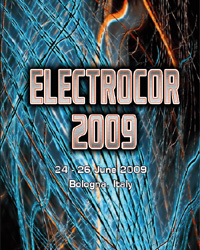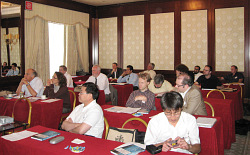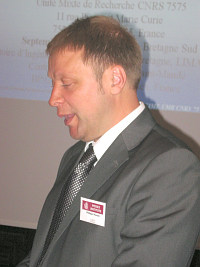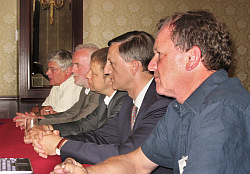Third International Conference on the Simulation of Electrochemical Processes
Bologna, Italy
Overview & Opening Address
 The 3rd International Seminar on Simulation of Electrochemical Processes took place recently in Bologna, organised by the Wessex Institute of Technology (WIT). The Co-Chairmen were Professor Carlos A Brebbia, Director of WIT, and Dr Robert Adey, Head of the Industrial Division of the same Institute.
The 3rd International Seminar on Simulation of Electrochemical Processes took place recently in Bologna, organised by the Wessex Institute of Technology (WIT). The Co-Chairmen were Professor Carlos A Brebbia, Director of WIT, and Dr Robert Adey, Head of the Industrial Division of the same Institute.The objective of the conference was to bring together researchers, engineers and scientists to present and discuss the state of the art in the computer simulation of electrochemical processes and applications in the area of corrosion, corrosion related fracture and fatigue and coating deposition processes.
The theme of the conference was the development of computational models and their applications in practice, including the comparison with experimental measurements and case studies.
The meeting was opened by Professor Carlos Brebbia who explained the objectives of WIT and the importance of the conference programme. The programme, which now includes nearly 30 meetings per year, is aimed at bringing together specialists from all over the world so that they can find ways of collaborating in addition to giving state of the art presentations during the conferences. This process of dissemination is one of the main functions of WIT, which aims to act as a mechanism for the dissemination of knowledge.
 Professor Brebbia also mentioned the type of interdisciplinary work carried out at WIT, describing this through a series of particular examples and case studies. He stressed the importance of being able to communicate across different disciplines as this is the only way in which the many problems facing society can be resolved.
Professor Brebbia also mentioned the type of interdisciplinary work carried out at WIT, describing this through a series of particular examples and case studies. He stressed the importance of being able to communicate across different disciplines as this is the only way in which the many problems facing society can be resolved.Finally, Professor Brebbia described some of the new developments taking place at WIT Press, the publishing arm of the Institute, which is now increasing the distribution of its scientific and technical archive in digital form. This has been carried out by appointing a network of distributors that cover the whole world. This will give a very wide dissemination to the papers presented at WIT conferences and is a direct consequence of the demands of modern libraries.
Keynote Addresses
 Following his remarks, Professor Brebbia introduced Professor Philippe Mandin, until recently Head of the Electrochemical Laboratory of the Ecole Nationale Superieure de Chimie in Paris. Professor Mandin is now based at the Université de Bretagne Sud. His keynote address was entitled “Numerical Modelling: from combustion science to electrochemical engineering” and described the different models that are equipped to take into account this type of problem.
Following his remarks, Professor Brebbia introduced Professor Philippe Mandin, until recently Head of the Electrochemical Laboratory of the Ecole Nationale Superieure de Chimie in Paris. Professor Mandin is now based at the Université de Bretagne Sud. His keynote address was entitled “Numerical Modelling: from combustion science to electrochemical engineering” and described the different models that are equipped to take into account this type of problem.Keynote addresses were also presented by other well known specialists:
- “Estimation of copper electroplating current densities by inverse analysis from electric potentials and magnetic field” by K. Amaya, Tokyo Institute of Technology, Japan
- “The EU FP6 integrated project “IMPRESS”: simulation across scales and across Europe” by S.G.R. Brown, University of Swansea, Wales
- “Fracture mechanics approach to stress-corrosion creaking: when hydrogen is the circumstance” by J. Toribio, University of Salamanca, Spain
- "Status and challenges in electrochemical modelling” by J Deconinck, Free University of Brussels, Belgium
Invited Papers
These interesting keynote addresses were complemented by a series of invited papers as follows:- “Computational modelling of cathodic protection systems for pipelines in multi-layer soil” by A B Peratta, Wessex Institute of Technology, UK
- “Numerical analysis assisted monitoring method for the coating condition on a ballast tank wall” by K. Amaya, Tokyo Institute of Technology, Japan
- “Field-based prediction of localized anodic dissolution events taking place on ZnAl alloy coatings in the presence of 5% NaCl solution” by S.G.R. Brown, University of Swansea, Wales
- “Numerical modelling of cathodic protection systems for deep wall casings” by R.A. Adey, Wessex Institute of Technology, UK
- “Atomistic simulation of the nanostructural evolution of Raney-type catalysts from spray-atomised NiAl processor alloys during” by N.C. Bernard, University of Cardiff, Wales
Social Events
The conference offered many opportunities for the delegates to meet in a friendly environment, not only during coffee breaks, but also at the complimentary lunches offered by the organisers.
The conference dinner took place in a renowned restaurant, considered by many as the best in Bologna. The restaurant, called Carraci, is located in the Palace of the Hotel Baglioni, which has frescos painted by the Carraci brothers, who developed their own Art School in the XVII Century. The delegates were offered local specialities accompanied by regional wines in the unique environment of the main restaurant, where the ceiling is decorated with frescos depicting stories from Roman mythology.
Panel Discussion
 A panel discussion on “The future of computational simulation in electrochemical processes” took place at the end of the second day of the conference. The panel consisted of Johan Deconinck, Steve Brown, Philippe Mandin, Jesus Toribio and Robert Adey, all well known specialists and members of the International Scientific Advisory Committee of ELECTROCOR 2009. Professor Carlos Brebbia chaired the panel and started by asking the specialists for their perception of the future of computational simulation in electrochemical processes.
A panel discussion on “The future of computational simulation in electrochemical processes” took place at the end of the second day of the conference. The panel consisted of Johan Deconinck, Steve Brown, Philippe Mandin, Jesus Toribio and Robert Adey, all well known specialists and members of the International Scientific Advisory Committee of ELECTROCOR 2009. Professor Carlos Brebbia chaired the panel and started by asking the specialists for their perception of the future of computational simulation in electrochemical processes.Johan started by explaining that, in his opinion, the development of Laplace type solvers was already done and could be used in practice. The main problem, however, was the lack of reliable data, particularly in the case of damaged coatings. He also thought that the multispecies modelling including 3D cases is still a challenging field that requires huge amounts of computer power. Multispecies solutions are particularly difficult in the case of crack corrosion and other problems involving dense media.
Steve thought that it is important to design new materials against corrosion as well as for the required mechanical properties. Many new materials, including nanomaterials, are developed without any consideration to corrosion.
Philippe stressed the importance of good quality research, with work carried out by teams renowned for their excellence. He finds problems related to boundary conditions particularly difficult as they used to take into consideration real life behaviour. Experiments, Philippe said, are expensive and we should use them to validate the behaviour of systems as well as to find material properties. Models all too frequently do not incorporate realistic boundary conditions.
Jesus explained that his motivation to participate in ELECTROCOR is because of the importance of understanding the role of stress mechanics in corrosion. The problems are not only related to electrochemistry, but to applied mechanics as well. He also emphasised the importance of cracks in corrosion. His recent work on H2 in particular made him all the more aware of this need. Computational models, he thinks, are not yet as well developed to tackle these problems.
Bob pointed out that in the case of the EU research undertaken at Ashurst Lodge on cracks in H2 environments, the experiments were very difficult to perform. In terms of stress corrosion, the models have been developed but there are not good measurements to validate them. The interest at WIT is in corrosion and CP and Ashurst Lodge has unique expertise in the field, however current data is still insufficient.
There were several comments from the audience and this gave rise to a lively discussion. Some of the industrial participants would like to see user-friendly computational codes with some intelligent systems. The design, they thought, has not yet progressed to the level of present day structural engineering for instance. Other participants mentioned the lack of interdisciplinary tools for many electrochemical applications for which two still unrelated disciplines are required, such as chemical engineering and computer modelling. The general agreement was that more and better experiments were required.
International Scientific Advisory Committee Meeting
The ISAC met over dinner to discuss ways in which the Conference can be enhanced. Of particular importance is the basic idea of having a forum for electrochemical engineers to meet with computer modellers to continue developing the field in a harmonic manner.Publication of Papers
 The proceedings of Simulation of Electrochemical Processes III, 400pp (Print ISBN: 1-84564-192-4; Online ISBN: 1-84564-369-0; Print ISSN: 1746-4471) are available from WIT Press priced at £79/US$142/€98. Orders can be placed by telephone: +44 (0) 238 029 3223, fax: +44 (0) 238 029 2853, e-mail:
The proceedings of Simulation of Electrochemical Processes III, 400pp (Print ISBN: 1-84564-192-4; Online ISBN: 1-84564-369-0; Print ISSN: 1746-4471) are available from WIT Press priced at £79/US$142/€98. Orders can be placed by telephone: +44 (0) 238 029 3223, fax: +44 (0) 238 029 2853, e-mail: Papers from the conference will also be hosted online at the WIT eLibrary as Volume 65 of WIT Transactions on Engineering Sciences (Online ISSN: 1743-3533). For more details visit the WIT eLibrary at www.witpress.com


 Wessex Institute
Wessex Institute